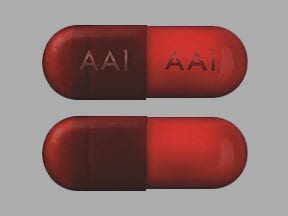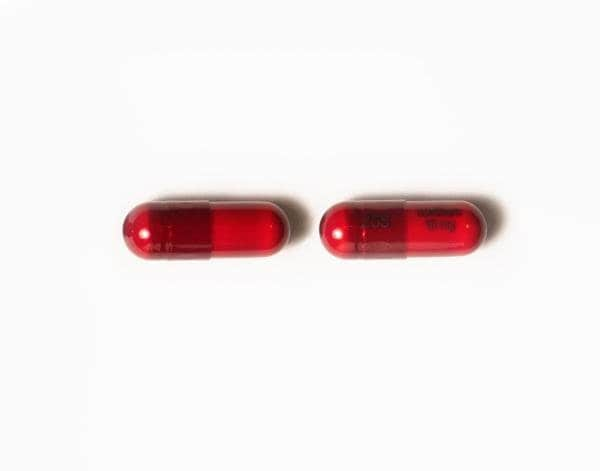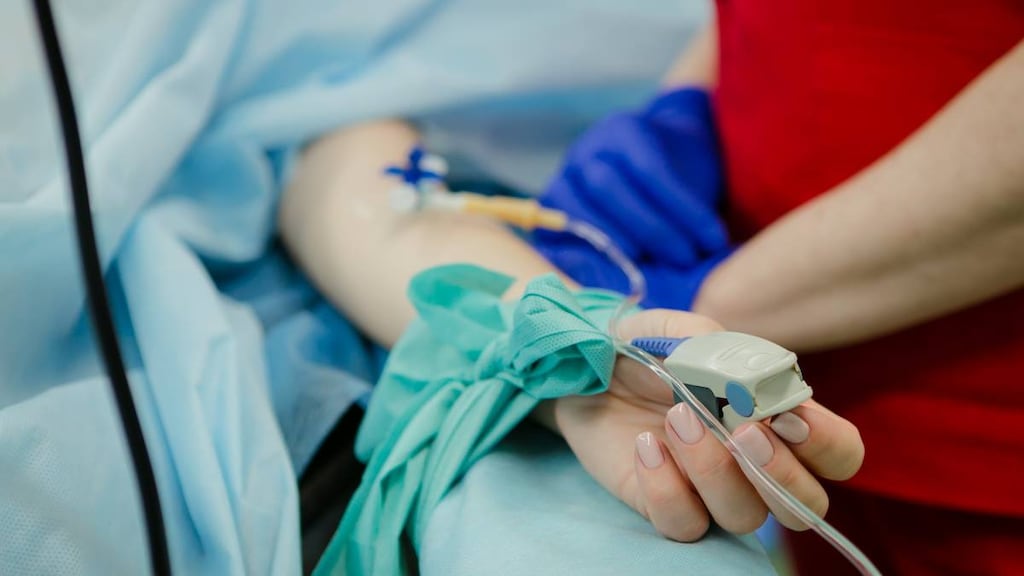Dosage Forms
Excipient information presented when available (limited, particularly for generics); consult specific product labeling. [DSC] = Discontinued product
Capsule, Oral:
Android: 10 mg [DSC] [contains brilliant blue fcf (fd&c blue #1), fd&c red #40]
Testred: 10 mg [DSC] [contains brilliant blue fcf (fd&c blue #1), fd&c red #40]
Generic: 10 mg
Tablet, Oral:
Methitest: 10 mg [scored]
Pharmacology
Mechanism of Action
Endogenous androgen stimulates receptors in organs and tissues to promote growth and development of male sex organs and maintains secondary sex characteristics in androgen-deficient males
Pharmacokinetics/Pharmacodynamics
Metabolism
Hepatic
Excretion
Urine (~90%); feces (~6%)
Half-Life Elimination
Variable: 10 to 100 minutes
Protein Binding
98% bound to sex hormone-binding globulin
Use: Labeled Indications
Males:
Delayed puberty: To stimulate puberty in carefully selected males with clearly delayed puberty.
Hypogonadotropic hypogonadism (congenital or acquired): Treatment of idiopathic gonadotropin or luteinizing hormone-releasing hormone (LHRH) deficiency, or pituitary hypothalamic injury from tumors, trauma, or radiation.
Primary hypogonadism (congenital or acquired): Treatment of testicular failure caused by cryptorchidism, bilateral torsion, orchitis, vanishing testis syndrome; or orchidectomy.
Females:
Breast cancer, metastatic: Secondarily in women with advancing inoperable metastatic (skeletal) mammary cancer who are 1 to 5 years postmenopausal; has also been used in premenopausal women with breast cancer who have benefited from oophorectomy and are considered to have a hormone-responsive tumor.
Contraindications
Men with breast cancer or with known or suspected prostate cancer; women who are or may become pregnant.
Documentation of allergenic cross-reactivity for androgens is limited. However, because of similarities in chemical structure and/or pharmacologic actions, the possibility of cross-sensitivity cannot be ruled out with certainty.
Dosage and Administration
Dosing: Adult
Note: In adult men with androgen deficiency syndromes (eg, hypogonadism), withhold initial treatment with hematocrit >50% (discontinue therapy if hematocrit exceeds 54%), untreated obstructive sleep apnea, uncontrolled severe heart failure, or with severe untreated BPH with IPSS symptom score >19 (Endocrine Society [Bhasin 2010]).
Breast cancer, metastatic (females): Oral: 50 to 200 mg daily
Delayed puberty (males): Oral: 10 to 50 mg daily; limit treatment duration to 4 to 6 months; use lower range of dosing and individualize dose based on response and tolerability.
Hypogonadotropic hypogonadism (congenital or acquired) and primary hypogonadism (congenital or acquired) (males): Oral: Initial: 10 to 50 mg daily; individualize dose based on response and tolerability.
Dosing: Geriatric
Refer to adult dosing.
Dosing: Pediatric
Delayed puberty: Adolescent males: Oral: Refer to adult dosing.
Hypogonadotropic hypogonadism (congenital or acquired) and primary hypogonadism (congenital or acquired): Adolescent males: Oral: Refer to adult dosing.
Administration
Administer orally.
Storage
Store at 15°C and 30°C (59°F and 86°F). Protect Methitest from light, moisture, and heat.
MethylTESTOSTERone Images
Drug Interactions
Ajmaline: Androgens may enhance the adverse/toxic effect of Ajmaline. Specifically, the risk for cholestasis may be increased. Monitor therapy
Blood Glucose Lowering Agents: Androgens may enhance the hypoglycemic effect of Blood Glucose Lowering Agents. Monitor therapy
C1 inhibitors: Androgens may enhance the thrombogenic effect of C1 inhibitors. Monitor therapy
Corticosteroids (Systemic): May enhance the fluid-retaining effect of Androgens. Monitor therapy
CycloSPORINE (Systemic): Androgens may enhance the hepatotoxic effect of CycloSPORINE (Systemic). Androgens may increase the serum concentration of CycloSPORINE (Systemic). Consider therapy modification
Vitamin K Antagonists (eg, warfarin): Androgens may enhance the anticoagulant effect of Vitamin K Antagonists. Consider therapy modification
Test Interactions
May decrease thyroxine-binding globulin, resulting in decreased total T4 serum levels and increased resin uptake of T3 and T4; free thyroid hormone levels are not changed.
Adverse Reactions
Frequency not defined.
Cardiovascular: Edema
Central nervous system: Anxiety, depression, headache, paresthesia
Dermatologic: Acne vulgaris, androgenetic alopecia
Endocrine & metabolic: Change in libido, gynecomastia (males), hirsutism (females), hypercalcemia, hypercholesterolemia, menstrual disease (includes amenorrhea)
Gastrointestinal: Nausea, vomiting
Genitourinary: Benign prostatic hypertrophy (males), impotence (males), mastalgia (females), oligospermia (males; at high doses), priapism (males), testicular atrophy (males), virilization (males and females)
Hematologic & oncologic: Clotting factors suppression, polycythemia, prostate carcinoma (males)
Hepatic: Abnormal liver function tests, cholestatic hepatitis, hepatic insufficiency, hepatic necrosis, jaundice, peliosis hepatitis
<1%, postmarketing, and/or case reports: Anaphylactoid reaction, hepatocellular neoplasm, hepatotoxicity (idiosyncratic; Chalasani 2014)
Warnings/Precautions
Concerns related to adverse effects:
- Cardiovascular events: Available studies are inconclusive regarding the risk of developing major adverse cardiovascular events (MACE) such as nonfatal MI, stroke, or cardiovascular death following testosterone use. Studies have suggested an increased risk of cardiovascular events among groups of men prescribed testosterone therapy (Basaria 2010; Finkle 2014; Vigen 2013). The Endocrine Society suggests it may be prudent to avoid testosterone therapy in men who have experienced a cardiovascular event (eg, MI, stroke, acute coronary syndrome) in the past six months (The Endocrine Society 2014). These risks are currently under review by the FDA (Drug Safety Communication 2014).
- Gynecomastia: May cause gynecomastia which may persist in patients treated for hypogonadism.
- Hepatic effects: Prolonged use and/or high doses may cause peliosis hepatis, hepatic neoplasms including hepatocellular carcinoma, cholestatic hepatitis, and jaundice. Discontinue if cholestatic hepatitis with jaundice or abnormal liver function tests occur.
- Oligospermia: May cause oligospermia and reduced ejaculatory volume after prolonged administration or excessive dosage.
- Polycythemia: May increase hematocrit requiring dose adjustment or discontinuation. Withhold initial treatment in patients with hematocrit >50%. Discontinue therapy if hematocrit exceeds 54%; may reinitiate at lower dose (Endocrine Society [Bhasin 2010]).
- Priapism: Priapism or excessive sexual stimulation may occur.
- Venous thromboembolism: Venous thromboembolic events, including deep vein thrombosis (DVT) and pulmonary embolism (PE), have been reported with testosterone products. Evaluate patients with symptoms of pain, edema, warmth, and erythema in the lower extremity for DVT and those with acute shortness of breath for PE. Discontinue therapy if a venous thromboembolism is suspected.
Disease-related concerns:
- Benign prostatic hyperplasia (BPH): Androgens may worsen BPH; do not use in patients with severe lower urinary tract symptoms [(AUA)/International Prostate Symptom Score (IPSS) > 19] (Endocrine Society [Bhasin 2010]). Discontinue therapy if urethral obstruction develops in patients with BPH (use lower dose if restarted).
- Breast cancer: May cause hypercalcemia (by stimulating osteolysis) in patients with breast cancer; discontinue if hypercalcemia occurs.
- Diseases exacerbated by fluid retention: Use with caution in patients with diseases that may be exacerbated by fluid retention, including cardiac impairment; may cause fluid retention. Treatment of androgen deficiency syndromes is not recommended for men with uncontrolled or poorly controlled heart failure (Endocrine Society [Bhasin 2010]).
- Hepatic impairment: Use with caution in patients with hepatic impairment; may cause fluid retention.
- Prostate cancer: May increase the risk of prostate cancer. Withhold therapy pending urological evaluation in patients with palpable prostate nodule or induration, PSA >4 ng/mL, or PSA >3 ng/mL in men at high risk of prostate cancer (Endocrine Society [Bhasin 2010]).
- Renal impairment: Use with caution in patients with renal impairment; may cause fluid retention.
- Sleep apnea: May potentiate sleep apnea in some male patients, especially those with risk factors (eg, obesity or chronic lung disease). Withhold initial treatment in patients with untreated obstructive sleep apnea (Endocrine Society [Bhasin 2010]).
Concurrent drug therapy issues:
- Drug-drug interactions: Potentially significant interactions may exist, requiring dose or frequency adjustment, additional monitoring, and/or selection of alternative therapy. Consult drug interactions database for more detailed information.
Special populations:
- Elderly: May be at greater risk for prostatic hyperplasia, and prostate cancer.
- Pediatric: May accelerate bone maturation (without producing compensatory gain in linear growth) and premature closure of the epiphyses in children; in prepubertal children, perform radiographic examination of the hand and wrist every 6 months to determine the rate of bone maturation and to assess the effect of treatment on the epiphyseal centers. Use with caution in males with delayed puberty.
- Women: During treatment for metastatic breast cancer, women should be monitored for signs of virilization; discontinue if mild virilization is present to prevent irreversible symptoms.
Other warnings/precautions:
- Abuse/misuse/diversion: Anabolic steroids may be abused, typically at doses higher than recommended and in combination with other anabolic androgenic steroids; abuse may be associated with serious cardiovascular and psychiatric adverse reactions. Inform patients of the serious adverse reactions associated with abuse of testosterone and anabolic androgenic steroids; if abuse is suspected, check serum testosterone levels (testosterone levels may be in the normal or subnormal range in men abusing synthetic testosterone derivatives). Consider the possibility of abuse in suspected patients who present with serious cardiovascular or psychiatric adverse events.
- Dependence: Drug dependence in individuals using approved doses of testosterone for approved indications has not been documented; however dependence may occur when used outside of approved dosage/indications.
Monitoring Parameters
Prior to treatment initiation: Confirm hypogonadism by measuring morning serum testosterone on at least 2 separate days. Liver function tests, lipid panel, hemoglobin and hematocrit (withhold initial treatment with hematocrit >50%) (Endocrine Society [Bhasin 2010]). PSA and prostate exam in men >40 years of age with baseline PSA >0.6 ng/mL.
During treatment:
Liver function tests, lipid panel, hemoglobin and hematocrit (at 3 to 6 months then annually); discontinue therapy if hematocrit exceeds 54% (Endocrine Society [Bhasin 2010]). Monitor urine and serum calcium and signs of virilization in women treated for breast cancer. Serum glucose (may be decreased by testosterone, monitor patients with diabetes). Evaluate males for response to treatment and adverse events 3 to 6 months after initiation and then annually; monitor for cardiovascular events closely during therapy. Monitor serum testosterone 3 to 6 months after initial dose titration (if applicable) then annually.
Bone mineral density:
Prepubertal children: Radiologic examination of wrist and hand every 6 months.
Hypogonadal men with osteoporosis or low trauma fracture: Monitor after 1 to 2 years of therapy (Endocrine Society [Bhasin 2010]).
PSA: In men >40 years of age with baseline PSA >0.6 ng/mL, PSA and prostate exam at 3 to 6 months, then as based on current guidelines. Withhold treatment pending urological evaluation in patients with palpable prostate nodule or induration or PSA >4 ng/mL or if PSA >3 ng/mL in men at high risk of prostate cancer (Endocrine Society [Bhasin 2010]).
Pregnancy
Pregnancy Risk Factor
X
Pregnancy Considerations
Use is contraindicated in women who are or may become pregnant. Exposure during pregnancy may cause virilization of the external genitalis of the female fetus, including clitoromegaly, abnormal vaginal development, and fusion of genital folds to form a scrotal-like structure. The degree of masculinization is dose related and most likely to occur when androgens are administered in the first trimester. If a patient becomes pregnant while taking androgens, she should be counseled on the potential hazard to the fetus.
Use of methyltestosterone may impair fertility; oligospermia may occur in males and amenorrhea may occur in females.
Patient Education
What is this drug used for?
- It is used to treat low testosterone levels.
- It is used to treat breast cancer in women.
- It may be given to you for other reasons. Talk with the doctor.
Frequently reported side effects of this drug
- Emotional instability
- Headache
- Enlarged breasts (males)
Other side effects of this drug: Talk with your doctor right away if you have any of these signs of:
- High calcium like weakness, confusion, fatigue, headache, nausea and vomiting, constipation, or bone pain
- Liver problems like dark urine, fatigue, lack of appetite, nausea, abdominal pain, light-colored stools, vomiting, or yellow skin.
- Electrolyte problems like mood changes, confusion, muscle pain or weakness, abnormal heartbeat, seizures, lack of appetite, or severe nausea or vomiting
- Severe cerebrovascular disease like change in strength on one side is greater than the other, difficulty speaking or thinking, change in balance, or vision changes
- Blood clots like numbness or weakness on one side of the body; pain, redness, tenderness, warmth, or swelling in the arms or legs; change in color of an arm or leg; chest pain; shortness of breath; fast heartbeat; or coughing up blood
- Virilization like in females a deep voice, facial hair, acne, or menstrual changes
- Enlarged clitoris
- Chest pain
- Arm pain
- Shoulder pain
- Shortness of breath
- Excessive weight gain
- Swelling of arms or legs
- Erection that lasts more than 4 hours
- Sexual dysfunction
- Nausea
- Vomiting
- Severe anxiety
- Lump in breast
- Breast pain or soreness
- Skin discoloration
- Bruising
- Bleeding
- Depression
- Mood changes
- Burning or numbness feeling
- Signs of a significant reaction like wheezing; chest tightness; fever; itching; bad cough; blue skin color; seizures; or swelling of face, lips, tongue, or throat.
Note: This is not a comprehensive list of all side effects. Talk to your doctor if you have questions.
Consumer Information Use and Disclaimer: This information should not be used to decide whether or not to take this medicine or any other medicine. Only the healthcare provider has the knowledge and training to decide which medicines are right for a specific patient. This information does not endorse any medicine as safe, effective, or approved for treating any patient or health condition. This is only a brief summary of general information about this medicine. It does NOT include all information about the possible uses, directions, warnings, precautions, interactions, adverse effects, or risks that may apply to this medicine. This information is not specific medical advice and does not replace information you receive from the healthcare provider. You must talk with the healthcare provider for complete information about the risks and benefits of using this medicine.



